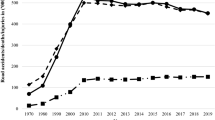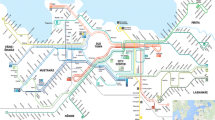Abstract
This paper analyses the occurrence of temporary speed restrictions in railway infrastructure associated with railway track geometry degradation. A negative binomial regression model is put forward to estimate the expected number of temporary speed restrictions, controlling for the main quality indicators of railway track geometry degradation and for the maintenance and renewal actions/decisions. The prediction of temporary speed restrictions provides a quantitative way to support the assessment of unavailability costs to railway users. A case study on the Lisbon–Oporto Portuguese line is explored, comparing three statistical models: the Poisson, the ‘over-dispersed’ Poisson and the proposed negative binomial regression. Main findings suggest that the main quality indicators for railway track geometry degradation are statistically significant variables, apart from the maintenance and renewal actions. Finally, a discussion on the impacts of the unavailability costs associated with temporary speed restrictions is also provided in a regulated railway context.

Similar content being viewed by others
References
Stenström C, Parida A, Galar D (2014) Performance indicators of railway infrastructure. Int J Railw Technol 1(3):1–18
Veiseth M, Olsson N, Saetermo IAF (2007) Infrastructure’s influence on rail punctuality. WIT Trans Built Environ 96:481–490
Vickerman R (2004) Maintenance incentives under different infrastructure regimes. Util Policy 12(4):315–322
Olsson NO, Haugland H (2004) Influencing factors on train punctuality—results from some Norwegian studies. Transp Policy 11(4):387–397
Luque R, Castro M (2016) Highway geometric design consistency: speed models and local or global assessment. Int J Civ Eng. doi:10.1007/s40999-016-0025-2
Hansen IA (2010) Railway Network timetabling and dynamic traffic management. Int J Civ Eng 8(1):19–32
Murali P, Dessouky M, Ordóñez F, Palmer K (2010) A delay estimation technique for single and double-track railroads. Transp Res Part E Logist Transp Rev 46(4):483–495
Schlake B, Barkan C, Edwards J (2011) Train delay and economic impact of in-service failures of railroad rolling stock. Transp Res Record J Transp Res Board 2261:124–133
Marinov M, Şahin İ, Ricci S, Vasic-Franklin G (2013) Railway operations, time-tabling and control. Res Transp Econ 41(1):59–75
Gorman MF (2009) Statistical estimation of railroad congestion delay. Transp Res Part E Logist Transp Rev 45(3):446–456
Vansteenwegen P, Van Oudheusden D (2007) Decreasing the passenger waiting time for an intercity rail network. Transp Res Part B Methodol 41(4):478–492
Nielsen OA, Landex A, Frederiksen RD (2008) Passenger delay models for rail networks. Sched Based Model Transp Netw Theory Appl 46:27
Higgins A, Kozan E, Ferreira L (1995) Modelling delay risks associated with train schedules. Transp Plan Technol 19(2):89–108
Andrade AR, Teixeira PF (2011) Biobjective optimization model for maintenance and renewal decisions related to rail track geometry. Transp Res Record J Transp Res Board 2261:163–170
Andrade AR, Teixeira PF (2014) Unplanned-maintenance needs related to rail track geometry. Proceedings of the Institution of Civil Engineers-Transport 167(6):400–410
EN 13848-5 (2008): Railway applications–Track–Track geometry quality—Part 5: Geometric quality levels
Andrade AR, Teixeira PF (2012) A Bayesian model to assess rail track geometry degradation through its life-cycle. Res Transp Econ 36(1):1–8
Andrade AR, Teixeira PF (2013) Hierarchical Bayesian modelling of rail track geometry degradation. Proc Inst Mech Eng Part F J Rail Rapid Transit 227(4):364–375
Andrade AR, Teixeira PF (2015) Statistical modelling of railway track geometry degradation using Hierarchical Bayesian models. Reliab Eng System Saf 142:169–183
Andrade AR, Teixeira PF (2016) Exploring different alert limit strategies in the maintenance of railway track geometry. J Transp Eng. doi:10.1061/(ASCE)TE.1943-5436.0000867
Sadeghi J (2010) Field investigation on vibration behavior of railway track systems. International J Civ Eng 8(3):232–241
Dahlberg T (2010) Railway track stiffness variations—consequences and countermeasures. Int J Civ Eng 8(1):1–12
Ver Hoef JM, Boveng PL (2007) Quasi-Poisson vs. negative binomial regression: how should we model overdispersed count data? Ecology 88(11):2766–2772
Guikema SD, Coffelt JP (2009) Practical considerations in statistical modeling of count data for infrastructure systems. J Infrastruct Syst 15(3):172–178
Madanat S, Ibrahim WHW (1995) Poisson regression models of infrastructure transition probabilities. J Transp Eng 121(3):267–272
Liu H, Davidson RA, Rosowsky DV, Stedinger JR (2005) Negative binomial regression of electric power outages in hurricanes. J Infrastruct syst 11(4):258–267
Evans AW (2013) The economics of railway safety. Res Transp Econ 43(1):137–147
Noland RB (2013) From theory to practice in road safety policy: understanding risk versus mobility. Res Transp Econ 43(1):71–84
Friebel G, Ivaldi M, Vibest C (2010) Railway (De)regulation: a European efficiency comparison. Economica 77:77–91
Acknowledgements
The authors would like to thank the support and collaboration of the Portuguese Railway Infrastructure Manager, REFER, E. P. E, and of the Portuguese Foundation for Science and Technology (FCT) through the project MODURAIL (PTDC/SEN-TRA/112975/2009) and MIT Portugal program through the PhD Grant (SFRH/BD/33785/2009).
Author information
Authors and Affiliations
Corresponding author
Ethics declarations
Funding
Portuguese Foundation for Science and Technology (FCT) and MIT Portugal. Portuguese Railway Infrastructure Manager (REFER).
Rights and permissions
About this article
Cite this article
Andrade, A.R., Teixeira, P.F. Assessing Temporary Speed Restrictions and Associated Unavailability Costs in Railway Infrastructure. Int J Civ Eng 16, 219–228 (2018). https://doi.org/10.1007/s40999-016-0121-3
Received:
Revised:
Accepted:
Published:
Issue Date:
DOI: https://doi.org/10.1007/s40999-016-0121-3




